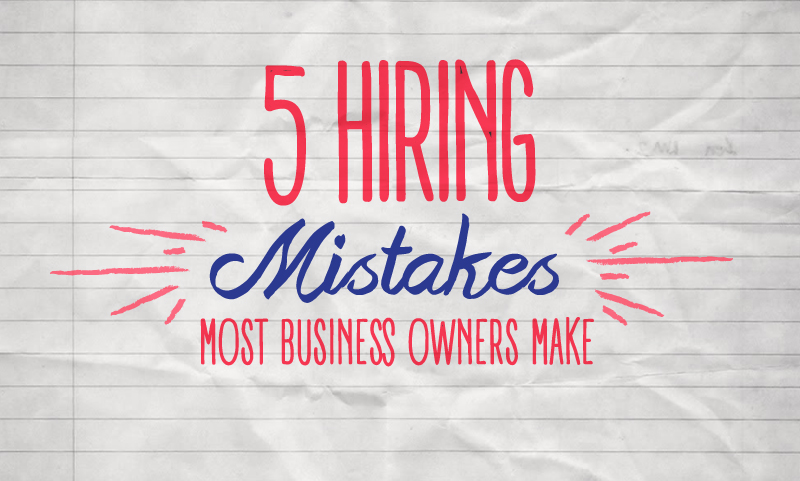5 Hiring Mistakes Most Business Owners Make

According to the Bureau of Labor Statistics, two out of three new hires will disappoint you. Employee turnover is a very costly detractor to a business’s bottom line. Hiring a new employee not only costs more than keeping an existing employee on board, it also can set companies back as much as a year and half in productivity due to orientation, training, and experience accumulation. Minimizing that expense starts with hiring the right employees the first time.
In fact, many of the employee-related hassles that businesses endure are the employer’s fault to begin with. Most issues arise from problems during the hiring process. Mistakes managers and business owners make during the employee search can have long lasting effects that can cripple a business for months, and even years down the road.
Below are 5 common mistakes you might be making during your hiring process:
1. Not Trusting Your Gut
Chances are you’ve developed enough of a gut over the years to tell if a person is being genuine or not within a few minutes of meeting them. This isn’t necessarily a managerial skill—we all do it in our personal lives—but you can use it to your advantage during the hiring process. No matter how good a potential new hire looks on paper, take a minute to really examine how you feel about them. Did they say something during the interview that struck you as odd or out of place? Maybe it was the way in which they said something, not necessarily what was said. Does their job history “make sense” to you, or does it look a bit scattered, weak, or fabricated? Are they too glib or too smooth in their interpersonal interactions? Job interviews should be at least a little stressful. If your candidate is sailing on a summer breeze during the interview, they may not be taking the process seriously.
All of these little tells pluck at your intuition—your gut feeling—and let you know if you think they’d make a good employee or not. If you feel something isn’t quite right, take the extra time to investigate the applicant more, or don’t offer them the job at all.
2. Not Digging Deep Enough
Your research into a potential new hire should go far beyond their resume. Most businesses do a criminal background check. Some even require a credit check. Many, however, never check references, calls previous employers, or even take the time to ask their current employees if they know the individual applying for the job. There are legal restrictions you have to keep in mind during the hiring process, but dig as deeply as you possibly can if a potential new hire looks good on paper. Back that positive impression up, and make sure your applicant is not trying to pull the wool over your eyes.
3. Hiring a Personality Instead of a Worker
This happens a lot with small businesses—especially when those in charge of hiring bring in friends or family to fill vacant positions. Sure, these people may be great individuals, and you may “know” them personally, but they may not make the best employees.
As a hiring manager, you can’t let yourself get hung up on the individual applicant’s personality. They may come into a job interview and act like you’re the best of friends, but often times that confidence, likability, and personality can hide critical flaws—like lack of experience, lack of knowledge, inability to separate work life from personal, and much more.
Keep in mind that even as a small business you shouldn’t be hiring friends —unless they are truly the best person for the job.
4. Hiring Too Quickly
You may feel a lot of pressure to fill empty spots on the payroll quickly, especially if those spots occur during your business’s busy season. The hiring process, however, isn’t something that should be rushed. Take the time to do a thorough background check. Check references and call previous employers. Ask the individual in for a second, or even third interview. And then wait.
By “sitting on” a decision, you give yourself time to digest all of the information you’ve just taken in. This doesn’t mean you should drag your feet, it just means that you should place the appropriate gravity on the situation. You’re looking for an employee that will be with you for the long run, one that will work with your current team, and one that can get up to speed in a relatively short amount of time. If you don’t get that employee the first time around, you’re going to have to go through the whole recruitment and hiring process all over again.
5. Failing to Accurately Outline a Job Description
As a hiring manager you can’t afford to sugar coat a job description. If you do, you’re going to end up with a quickly disgruntled employee who will likely walk out and leave you in a lurch. You have to paint an accurate as possible picture of the job as you can. You have to disclose what is expected of the employee in order to truly find the right person for the job.
Always Improve Your Hiring Skills
You’re not always going to get it right the first time. There will be employee who look great on paper, start out wonderfully, and then go downhill quickly. On the other hand, you’ll also find that some of the new hires who just barely made the cut become some of your best employees. You’ll learn from experience. The trick to finding the best employees for your company is to use what you learn to make improvements to your hiring process over time.
What other hiring mistakes have you made in the past? Leave a comment below.
Click here to see how other companies just like you save time and hassle with easy employee scheduling tools.






